https://doi.org/10.1029/2021GL095895
Giuliano Liuzzi, Geronimo L. Villanueva, Loïc Trompet,Matteo M. J. Crismani,Arianna Piccialli,Shohei Aoki,Miguel Angel Lopez-Valverde,Aurélien Stolzenbach,Frank Daerden,Lori Neary,Michael D. Smith,Manish R. Patel,Stephen R. Lewis,R. Todd Clancy,Ian R. Thomas,Bojan Ristic,Giancarlo Bellucci,Jose-Juan Lopez-Moreno, Ann Carine Vandaele
We present observations of terminator CO2 ice clouds events in three groups: Equatorial dawn, Equatorial dusk (both between 20°S and 20°N) and Southern midlatitudes at dawn (45°S and 55°S east of Hellas Basin) with ESA ExoMars Trace Gas Orbiter's Nadir and Occultation for MArs Discovery instrument. CO2 ice abundance is retrieved simultaneously with water ice, dust, and particle sizes, and rotational temperature and CO2 column profiles in 16 of 26 cases. Small particles (<0.5 μm) prevail at dusk, while water ice likely provides most source nuclei at dawn. Clouds east of Hellas are found to be dominantly nucleated on surface-lifted dust. CO2 ice is sometimes detected in unsaturated air together with dust nuclei at dawn, suggesting ongoing sublimation. Depending on latitude and local time, the interplay between particle precipitation and the lifetime of temperature minima (i.e., cold pockets) determines CO2 ice properties.

(a) Summary of the detections in the Equatorial region at dusk, dawn (b) and in the Hellas region at dawn (c). The plots report only the cases in which temperature (and CO2 saturation ratio, contours) is retrieved together with the properties of dust (orange dots), CO2 ice (white) and water ice (blue).